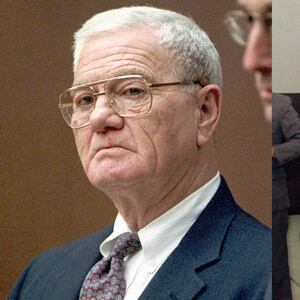TikTok user @fatalfaye delicately brushes a hot pink eyeshadow in the shade “Emoji” onto their eyelid. Over the primping plays an audio clip, crackling with feedback. “I just killed my mom and my sister,” a teenager confesses. The combination of the jarring 911 call and an otherwise normal makeup video may seem bizarre, but the incongruous pairing belongs to a trend of true crime makeup videos that has been growing in popularity across social media platforms like YouTube and TikTok.
Welcome to the weird world of true crime makeup videos.
In January 2019, YouTuber Bailey Sarian uploaded her first “Murder, Mystery & Makeup” vlog about the case of Chris Watts, a man who murdered his pregnant wife and two daughters (the case would later become the subject of a Netflix documentary, American Murder: The Family Next Door). Sarian was already a seasoned YouTuber in the makeup arena and decided to talk about the case while getting ready, though it is clear that she wasn’t sure how the macabre shift would sit with viewers. “Let me talk about somebody getting murdered while I do my makeup,” Sarian says, her voice dripping with self-derision. “I don’t even know how to approach this without sounding insensitive at all,” she admits. Sarian’s gamble proved successful, as reflected by her social media success. To date she has over 5.65 million YouTube subscribers and boasts an additional 2.1 million followers on TikTok.
ADVERTISEMENT
True crime is not a new genre by any means. While shows like Dateline, The First 48, Forensic Files and 20/20 have long buoyed true crime, the genre has lately been bolstered by forms of easily digestible media. In the mid-2010s, podcasts Serial and My Favorite Murders came onto the scene, revolutionizing the consumption and accessibility of murder-mystery media and drawing younger generations into the hype. Streaming platforms also hopped on the trend, releasing docuseries like The Jinx and Making a Murderer. Suddenly, decades-old murders were all anybody could talk about.
There’s nothing inherently wrong with true crime media, in theory. It stokes morbid curiosity while stopping short of personal engagement with tragedy. When something terrible and unnatural happens, there is an innate desire to get to the bottom of things, and media is one of the more harmless ways to scratch the itch. But thanks to the “true crime boom,” mysterious disappearances and murder cases that once filled the late-night hours of cable have inundated social media platforms, where it’s become more common for tragedy to be handled with insensitivity and, often, flagrant disrespect. The breakneck speed of social media increases the likelihood of causing offense to victims’ memories and long-lasting pain to the bereaved.
One of the most unsavory aspects of DIY true crime content is the necessity of self-promotion. The constant barrage of reminders to “like and subscribe,” or to “use my code for 20% off,” are not exclusive to the genre—it’s a prerequisite for anybody who operates within the content-creator economy. Those who wish to monetize their platforms have to go the extra mile to market themselves as a product. But when content becomes intrinsically linked to horrific violence and trauma, other people (both dead and alive) become involved.
A growing critique of the genre as a whole is the tendency to lean into crass marketing and clickbait titles, especially when cases deal with children and sexual violence. In one video, Sarian begins the video by revealing her nail polish line with Loud Lacquer, aptly dubbed “Murder Mystery Mani,” before delving into the case of Andrei Chikatilo, a serial child rapist and murderer. In another instance, one Twitter user condemned The Jenny McCarthy Show for using a suggestive photo of a contributor fellating a banana as the thumbnail for an episode about the gruesome murder of a child.
Sarian may have revolutionized true crime makeup videos, but she is far from the genre’s only creator. Danielle Kirsty has also become a well-known true crime makeup YouTuber, currently raking in 265K subscribers. On TikTok, users aim to tackle brutal and violent cases while completing a full makeup look in the limited time allotted. TikTokker @literallylizzi is a beacon of the success of short form true crime makeup videos, as evidenced by her 3.9 million followers and 131.6 million likes. Many of these creators stress the importance of being respectful of victims and their families. But circulating the gory details of how a person’s life was taken, or treating a victim as a plot development, can cause very real hurt to the loved ones left behind. While creators claim that respect is paramount, sensationalizing the death of another human for views is antithetical to the cause. Creators, though they may have the purest of intentions, are also not in control of what happens once their video leaves the drafts. The increased eyes on these cases have led average people to become armchair detectives, overrunning comments sections with tawdry speculation.
@literallylizzi Case of Rebecca Wertz (full vid on YT) #crimetok #truecrime #makeupstorytime #pov #rebeccawertz #makeup c: @jennylynn810 Ib: @itsallasimulatiion ♬ original sound - Coop 🦋
No such case has underscored the dehumanization of victims of violent crimes—and often domestic violence—than that of Gabby Petito. The case of the 22-year-old van life blogger who went missing on a road trip with her boyfriend swiftly gained media traction and has become emblematic of “missing white woman syndrome,” coined by the late journalist Gwen Ifill. The notion that cases that receive the most media attention are those of pretty young white women aligns with much of true crime’s ethos, and can easily be reflected in viral digital content. While white women who go missing are thrust under a microscope, the hordes of missing and murdered women of color are not even deemed important enough for a true crime makeup video, let alone a morsel of attention from law enforcement. Petito’s case gained massive traction due to the snowballing of traditional media attention in conjunction with social media, which has spawned countless homegrown accounts devoted to the case, including makeup ones. As expected, amateur theorists and true crime junkies quickly overran comments sections, speculating on what could have happened to Petito.
@manicpixiemom Sumner had a fascinating career on the railroad. 🚂 #gravetok #gravestonecleaning #fyp #railroadhistory ♬ original sound - Manic Pixie Mom
Some creators have taken a different, more compassionate approach to content surrounding death. TikTokker Caitlin Abrams, known by her handle @manicpixiemom, has grown a loyal following of 1.6 million users by cleaning weathered graves while discussing the decedent’s life, death, and legacy. She is meticulous in her work, both in restoring the headstones to their former glory and in her research about the full, rich lives her subjects lived. Abrams’ work satisfies the same urge to know the details of death, but the critical difference is that hers is built on a foundation of benevolence. Those who find the true crime genre to be therapeutic can take pleasure in Abrams’ videos with the knowledge that the dead are treated with dignity.
While the genre’s exploitative tendencies are often brushed aside, shows like Only Murders in the Building have forced creators and aficionados alike to reckon with their treatment of victims in pursuit of entertainment. Steve Martin’s Charles and Martin Short’s Oliver are true crime-obsessed neighbors who become consumed by a self-appointed project: producing a murder-mystery podcast about a gruesome, unsolved killing in their building. Only Murders in the Building smartly satirizes the sensationalizing nature of the genre, with Selena Gomez’s Mabel acting as an anchor to humanity. Despite the blasé attitude of the men, Mabel refuses to flatten the victim into a one-dimensional plot point. While the show is rooted in satire and in fiction, it certainly imparts very real wisdom about who true crime narratives really serve. Perhaps other creators should take note.







